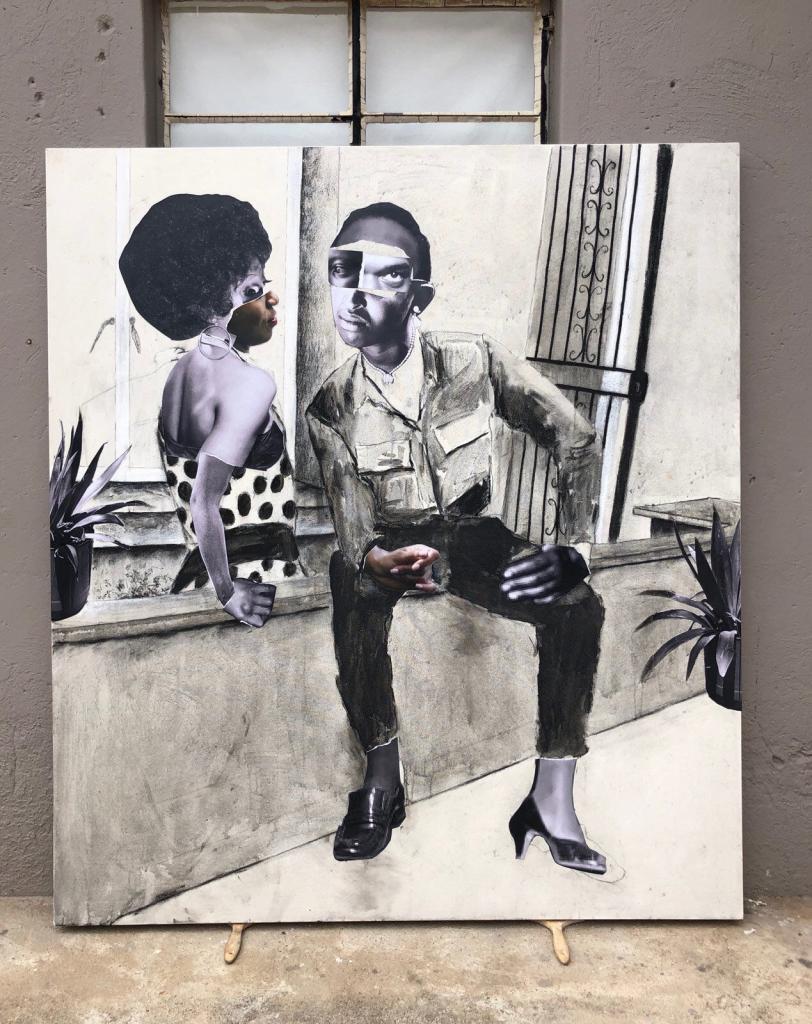Neo Matloga presents Back of the Moon
Based between South Africa and the Netherlands, Neo Matloga describes his process as straddling choreography, conducting and creation. Inspired by scenes in plays, local soap operas and family albums, he manipulates images taken from books and magazines digitally, then overlays painterly compositions in charcoal, ink and liquid charcoal to produce orchestral combinations he terms ‘collage paintings’.

In Back of the Moon, the artist presents large-scale, multi-panel works, extending his exploration of the collage technique both on and with the canvas. Following two years studying painting at Amsterdam’s De Ateliers, the artist attributes his gravitation towards a mixed-media approach to an affection for line drawing and materials with a connection to South Africa’s political past, as well as the conceptual undercurrent provided by rupturing, layering and forming hybridities.

Collage, charcoal, charcoal liquid and ink on canvas
200 x 250cm
The artist writes:
I thought about what it means to offer my practice from a social and aesthetic context and point of view. I made the conscious decision to continue making the interiors using a monochromatic palette, partially due to the fact that this use of colour makes the figures difficult to place in time – my characters appear in scenes from an alternative, personal existence.
With all figurative painting, the most important question asked is, who are the people in the painting? In my collage paintings, the figures refuse to solidify into simply drawn or painted material; there is a living presence there on the canvas that cannot be looked away from.

Collage, charcoal, charcoal liquid and ink on canvas
170 x 200cm
The scenes in this exhibition take place in bedrooms, living rooms, kitchens, stoeps and studies, with figures depicted in ambiguous confrontations and embraces, interspersed with solitary moments. Matloga employs contradictory arrangements of posture and expression, offering a kaleidoscope of interiors and interiorities that question common understandings of social relations. The artist continues:
Although the scenes are socially confirmed, living with the work in studio made me realise that I’m creating situations that I know are not for me to understand, meaning I’m not able to decipher the expressions of these souls even though I highly connect with and to them.
The questions that arise about the people in the paintings are part and parcel of the concept. At the centre is an allegory that speaks to the importance of carrying on with life, living and existing in the midst of all the socio-politics.

Collage, charcoal, charcoal liquid and ink on canvas
170 x 200cm
In a review of the artist’s 2019 solo exhibition at the Fries Museum, Neo to Love, Machteld Leij observed, ‘Matloga’s work is political, personal and universal at the same time. Growing up in a deeply troubled, racist society does leave its traces. These are counterbalanced by family life, love, friendship and the joy of living.’ In Back of the Moon, the artist continues his observations on tenderness and trauma, stating:
I decided to name this exhibition Back of the Moon not because I’m illustrating this beautiful phenomenon but more because the creative process of these artworks happened at night in the light of the moon, from my studio in Limpopo.
One evening I watched The Suit which is about the moment when domestic happiness turns into domestic violence. Similar stories happen within my surroundings. It strengthened my belief of being against jealousy, harassment and marital strife, but perhaps the violence lies translated in the collage technique. Even though there’s no set formula in studio, by starting with collage, I’m simultaneously distorting and recreating the integrity of the face.
For me the collage element makes the coherence of the canvas even more difficult to grasp. It would be illogical of me to ignore the fact that portraying everyday black life is somewhat of a political act but I will not take on the title of an activist or politically explicit artist, based on my simple observation that people do not stop being moral agents.

Collage, charcoal, charcoal liquid and ink on canvas
180 x 320cm
Back of the Moon is Neo Matloga’s first solo exhibition with Stevenson Johannesburg – For any inquiries and information about the works in this exhibition please contact: info@stevenson.info







